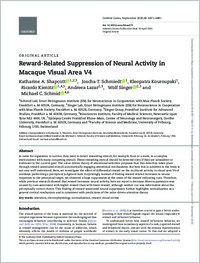Reward-related suppression of neural activity in macaque visual area v4
- Shapcott, Katharine A. Schmid Lab, Ernst Strüngmann Institute (ESI) for Neuroscience in Cooperation with Max Planck Society, Frankfurt a. M. 60528, Germany - Singer Lab, Ernst Strüngmann Institute (ESI) for Neuroscience in Cooperation with Max Planck Society, Frankfurt a. M. 60528, Germany - Singer Group, Frankfurt Institute for Advanced Studies, Frankfurt a. M. 60438, Germany
- Schmiedt, Joscha T. Schmid Lab, Ernst Strüngmann Institute (ESI) for Neuroscience in Cooperation with Max Planck Society, Frankfurt a. M. 60528, Germany
- Kouroupaki, Kleopatra Schmid Lab, Ernst Strüngmann Institute (ESI) for Neuroscience in Cooperation with Max Planck Society, Frankfurt a. M. 60528, Germany
- Kienitz, Ricardo Schmid Lab, Ernst Strüngmann Institute (ESI) for Neuroscience in Cooperation with Max Planck Society, Frankfurt a. M. 60528, Germany - Biosciences Institute, Faculty of Medical Sciences, Newcastle upon Tyne NE2 4HH, UK - Epilepsy Center Frankfurt Rhine-Main, Center of Neurology and Neurosurgery, Goethe University, Frankfurt a. M. 60528, Germany
- Lazar, Andreea Singer Lab, Ernst Strüngmann Institute (ESI) for Neuroscience in Cooperation with Max Planck Society, Frankfurt a. M. 60528, Germany - Singer Group, Frankfurt Institute for Advanced Studies, Frankfurt a. M. 60438, Germany
- Singer, Wolf Singer Lab, Ernst Strüngmann Institute (ESI) for Neuroscience in Cooperation with Max Planck Society, Frankfurt a. M. 60528, Germany - Singer Group, Frankfurt Institute for Advanced Studies, Frankfurt a. M. 60438, Germany
- Schmid, Michael Christoph Biosciences Institute, Faculty of Medical Sciences, Newcastle upon Tyne NE2 4HH, UK - Faculty of Science and Medicine, University of Fribourg, Fribourg 1700, Switzerland
-
30.07.2020
Published in:
- Cerebral Cortex. - 2020, vol. 30, no. 9, p. 4871–4881
English
In order for organisms to survive, they need to detect rewarding stimuli, for example, food or a mate, in a complex environment with many competing stimuli. These rewarding stimuli should be detected even if they are nonsalient or irrelevant to the current goal. The value-driven theory of attentional selection proposes that this detection takes place through reward-associated stimuli automatically engaging attentional mechanisms. But how this is achieved in the brain is not very well understood. Here, we investigate the effect of differential reward on the multiunit activity in visual area V4 of monkeys performing a perceptual judgment task. Surprisingly, instead of finding reward-related increases in neural responses to the perceptual target, we observed a large suppression at the onset of the reward indicating cues. Therefore, while previous research showed that reward increases neural activity, here we report a decrease. More suppression was caused by cues associated with higher reward than with lower reward, although neither cue was informative about the perceptually correct choice. This finding of reward-associated neural suppression further highlights normalization as a general cortical mechanism and is consistent with predictions of the value-driven attention theory.
- Faculty
- Faculté des sciences et de médecine
- Department
- Département de Médecine
- Language
-
- English
- Classification
- Biological sciences
- License
- License undefined
- Identifiers
-
- RERO DOC 329774
- DOI 10.1093/cercor/bhaa079
- Persistent URL
- https://folia.unifr.ch/unifr/documents/309001
Statistics
Document views: 66
File downloads:
- sch_rrs.pdf: 167
